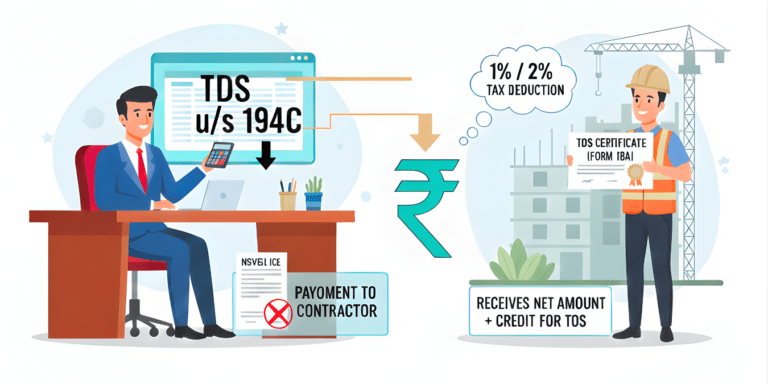
” How much money can you save in your bank savings account without paying tax. Learn about tax-free savings limits, interest rates, and expert tips to maximize your savings and minimize tax liability in India.”
A savings account is one of the most popular financial tools for individuals to store money securely while earning a modest interest. However, a common question that arises is: “How much money can I save in my bank savings account without tax?” This question often stems from confusion about taxation rules, interest income, and cash deposit limits under the Income Tax Act, 1961. In this comprehensive blog post, we’ll dive into the latest data, explore tax implications on savings account interest, and provide actionable insights to help you maximize your savings without attracting tax scrutiny. Whether you’re a salaried individual, a senior citizen, or a small business owner, this guide will clarify everything you need to know about tax-free savings in India.
Understanding Taxation on Savings Accounts in India
Before answering the core question, it’s essential to understand that the money you save in your bank account isn’t taxed—rather, it’s the interest earned on that money that may be subject to taxation. Additionally, large cash deposits can attract scrutiny from the Income Tax Department, even if they don’t directly result in tax liability. Let’s break this down step-by-step with the latest regulations and limits.
How Much Interest Can You Earn Tax-Free?
The interest earned on a savings account is considered “Income from Other Sources” under the Income Tax Act and is taxable based on your income slab. However, there are provisions that allow you to earn a certain amount of interest tax-free.
Section 80TTA: Tax Exemption for Individuals and HUFs
Under Section 80TTA, individuals and Hindu Undivided Families (HUFs) below the age of 60 can claim a deduction of up to ₹10,000 per financial year on the interest earned from savings accounts. This applies to savings accounts held with banks, cooperative societies, or post offices. Here’s how it works:
- If your total interest income from all savings accounts in a financial year is ₹10,000 or less, you don’t pay any tax on it.
- If it exceeds ₹10,000, only the amount above ₹10,000 is added to your taxable income and taxed as per your slab rate.
For example:
- Interest Earned: ₹8,000 → Fully exempt under Section 80TTA.
- Interest Earned: ₹15,000 → ₹10,000 exempt, ₹5,000 taxable as per your slab.
Latest Update : There have been discussions in the Union Budget 2024-25 about potentially increasing this limit to ₹25,000 to encourage savings and boost bank deposits. However, as of now, the limit remains ₹10,000 unless an official announcement is made in the upcoming budget or amendments.
Section 80TTB: Tax Exemption for Senior Citizens
For senior citizens (aged 60 years and above), Section 80TTB provides a higher deduction of up to ₹50,000 per financial year. This applies to interest earned from savings accounts, fixed deposits, and other deposits.
For example:
- Interest Earned: ₹40,000 → Fully exempt under Section 80TTB.
- Interest Earned: ₹60,000 → ₹50,000 exempt, ₹10,000 taxable.
This makes savings accounts more attractive for senior citizens looking to park their money without worrying about tax on interest income up to ₹50,000.
How Much Money Can You Save to Stay Tax-Free?
The amount you can save in your bank account without tax depends on the interest rate offered by your bank and the tax exemption limit applicable to you. Let’s calculate this with real-world examples based on typical savings account interest rates in India.
Typical Savings Account Interest Rates
- State Bank of India (SBI): 2.70% p.a. for balances below ₹10 crore.
- Axis Bank: 3.00%–3.50% p.a. depending on balance slabs.
- Kotak Mahindra Bank: Up to 4.00% p.a. for higher balances.
- Average Rate: Around 3%–4% p.a.
Calculation for Non-Senior Citizens (Section 80TTA)
- Exemption Limit: ₹10,000
- Interest Rate: 3% p.a.
- Formula: Principal = Exemption Limit / (Interest Rate / 100)
- Principal = ₹10,000 / (3 / 100) = ₹3,33,333
This means you can save approximately ₹3.33 lakh in your savings account at a 3% interest rate without paying tax on the interest. At a 4% rate, this drops to ₹2.5 lakh.
Calculation for Senior Citizens (Section 80TTB)
- Exemption Limit: ₹50,000
- Interest Rate: 3% p.a.
- Principal = ₹50,000 / (3 / 100) = ₹16,66,667
Senior citizens can save up to ₹16.67 lakh at 3% interest or ₹12.5 lakh at 4% interest without tax liability on the interest earned.
Key Takeaway: The principal amount you can save tax-free depends on the interest rate. The lower the rate, the more you can save without crossing the exemption limit.
Cash Deposit Limits: Avoiding Tax Scrutiny
While the principal amount in your savings account isn’t taxed, depositing large sums of cash can attract attention from the Income Tax Department. Here’s what you need to know about cash deposit limits:
Annual Cash Deposit Limit
Under Section 114B of the Income Tax Act, banks must report cash deposits or withdrawals exceeding ₹10 lakh in a financial year (April 1–March 31) in savings accounts to the Income Tax Department. This doesn’t mean the amount is taxed—it means you may need to explain the source of funds if questioned.
- Example: If you deposit ₹12 lakh in cash across multiple transactions in a year, the bank will report it. You’ll need documentation (e.g., salary slips, sale proceeds) to prove it’s legitimate income.
Daily Cash Transaction Limit
Under Section 269ST, you cannot receive or deposit more than ₹2 lakh in cash in a single day from one person or for one transaction/event. Violating this can lead to a penalty equal to the amount involved.
- Example: Depositing ₹3 lakh in cash in one day could result in a ₹3 lakh penalty, even if it’s your own money.
PAN Requirement
For cash deposits exceeding ₹50,000 in a single day, you must provide your PAN details. If you don’t have a PAN, you’ll need to submit Form 60/61.
Pro Tip: To avoid scrutiny, use digital transfers (NEFT, RTGS, UPI) instead of cash for large amounts, as these don’t fall under the same reporting thresholds.
Practical Scenarios: How Much Can You Save?
Let’s explore some real-life scenarios to answer the question based on your profile:
Scenario 1: Salaried Individual (Age 35)
- Annual Income: ₹8 lakh (30% tax slab)
- Savings Account Balance: ₹3 lakh
- Interest Rate: 3% p.a.
- Interest Earned: ₹9,000
- Tax Implication: Fully exempt under Section 80TTA (₹10,000 limit).
- Cash Deposits: ₹5 lakh in a year (digital transfer) → No scrutiny.
Result: You can save ₹3 lakh without tax on interest and deposit up to ₹10 lakh in cash annually without immediate tax issues, provided you can justify the source.
Scenario 2: Senior Citizen (Age 65)
- Annual Income: ₹5 lakh (20% tax slab)
- Savings Account Balance: ₹15 lakh
- Interest Rate: 3% p.a.
- Interest Earned: ₹45,000
- Tax Implication: Fully exempt under Section 80TTB (₹50,000 limit).
- Cash Deposits: ₹8 lakh in a year → Reported, but no tax if source is explained (e.g., pension).
Result: You can save ₹15 lakh tax-free on interest and deposit large sums if documented properly.
Scenario 3: High Net-Worth Individual
- Annual Income: ₹50 lakh (30% tax slab + surcharge)
- Savings Account Balance: ₹50 lakh
- Interest Rate: 4% p.a.
- Interest Earned: ₹2 lakh
- Tax Implication: ₹10,000 exempt (80TTA), ₹1.9 lakh taxable at 30% = ₹57,000 tax.
- Cash Deposits: ₹20 lakh in a year → Reported, requires source proof.
Result: You’ll pay tax on interest beyond ₹10,000, and large cash deposits need justification.
Tips to Maximize Tax-Free Savings
- Choose Low-Interest Accounts: Opt for banks with lower interest rates (e.g., 2.7% at SBI) to keep interest below the exemption limit while saving more principal.
- Spread Across Accounts: The ₹10,000/₹50,000 limit applies to total interest, not per account. Multiple accounts won’t increase the exemption but can help manage cash flow.
- Invest Excess Funds: Move money beyond the tax-free limit to tax-saving instruments like PPF or ELSS under Section 80C (up to ₹1.5 lakh deduction).
- Go Digital: Avoid cash deposits exceeding ₹10 lakh annually to stay off the tax radar.
- File ITR Correctly: Declare all interest income in your Income Tax Return (ITR) under “Income from Other Sources” and claim deductions under 80TTA/80TTB.
Latest Updates: What’s Changing?
- Proposed 80TTA Increase: Posts on X and media reports from mid-2024 suggested a potential hike in the Section 80TTA limit to ₹25,000 in the 2024-25 Budget. As of April 2025, this hasn’t been confirmed, but it could allow non-senior citizens to save up to ₹8.33 lakh at 3% interest tax-free if implemented.
- New Tax Regime: Under the new tax regime (introduced in 2020 and revised in 2023), Section 80TTA and 80TTB deductions are unavailable. If you opt for this, all interest income is taxable, reducing your tax-free savings potential.
- Digital Reporting: Banks are increasingly using AI-driven tools to monitor and report high-value transactions, making compliance more critical.
Common Myths Debunked
- Myth: “There’s no tax on savings accounts because there’s no TDS.”
- Fact: Unlike fixed deposits, savings accounts don’t have TDS, but interest above the exemption limit is taxable.
- Myth: “I can avoid tax by splitting money across multiple accounts.”
- Fact: The ₹10,000/₹50,000 limit applies to total interest, not per account.
- Myth: “Cash deposits are taxed directly.”
- Fact: Deposits aren’t taxed, but unexplained cash can lead to scrutiny or penalties.
How Much Can You Really Save Tax-Free?
To summarize:
- Non-Senior Citizens: You can save around ₹2.5 lakh–₹3.33 lakh (at 3%–4% interest) without tax on interest, thanks to Section 80TTA’s ₹10,000 exemption.
- Senior Citizens: You can save ₹12.5 lakh–₹16.67 lakh (at 3%–4% interest) under Section 80TTB’s ₹50,000 limit.
- Cash Deposits: Keep annual cash deposits below ₹10 lakh and daily transactions below ₹2 lakh to avoid scrutiny.
By understanding these limits and planning your finances, you can optimize your savings account to stay tax-free. Stay updated with Budget 2025 announcements, as changes to Section 80TTA could further boost your tax-free savings potential. For personalized advice, consult a tax professional to align your savings with your income profile.
-

RBI’s Approval: HDFC Group Gets 9.5% Stake Nod in IndusInd Bank
-

SBI’s YONO 2.0 Promises Faster, Smarter, Safer Payments — A Real Threat to PhonePe & GooglePay?
-

Indian Stocks Fall as Foreign Investors Extend Sell-Off: What’s Behind the Market Jitters?
-

BlackRock’s $140M Ethereum Dump: Hidden Opportunity for Indian Investors?





























